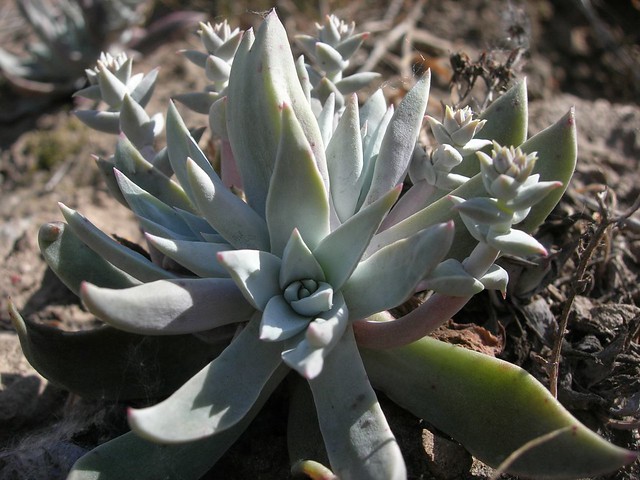Dudleya verityi Cladus: Eukaryota Name Dudleya verityi K.Nakai References * Cactus and Succulent Journal. [Cactus and Succulent Society of America] 55:196. 1983 Dudleya verityi is a rare species of succulent plant known by the common name Verity's liveforever. It is endemic to Ventura County, California, where it is known from only three occurrences in the vicinity of Conejo Mountain between Camarillo and Thousand Oaks.[1] It probably occurs in a few additional locations nearby which have not yet been officially vouchered.[2]
This is a fleshy perennial plant growing from a branching caudex several centimeters long. The leaves appear in a basal rosette about the caudex, each oblong to lance-shaped and generally pointed. The leaves are waxy in texture, pale grayish or pinkish green in color, and up to 5 centimeters long. The erect inflorescence is composed of a bract-lined peduncle up to 15 centimeters tall which splits into terminal branches each bearing several flowers. The flower has a base of fleshy, triangular sepals and longer, bright yellow petals just over a centimeter long. Ecology This dudleya associates with mosses and lichens. It often grows in layers of the lichen Niebla ceruchoides, which may provide a moisture-capturing bed for seeds that fall from it. This dudleya hybridizes with other species, such as Blochman's liveforever (Dudleya blochmaniae).[2] This species is only found on one edge of the Santa Monica Mountains, where it occurs in coastal sage scrub habitat. The dominant plants are California sagebrush (Artemisia californica), California buckwheat (Eriogonum fasciculatum) and purple sage (Salvia leucophylla). At least two occurrences are within the campus bounds of California State University, Channel Islands.[2] Conservation It is a federally listed threatened species, with the main threat to its existence being destruction of its habitat for development, mining, and flood control.[1] References ^ a b California Native Plant Society Rare Plants Profile Source: Wikipedia, Wikispecies: All text is available under the terms of the GNU Free Documentation License |
|

